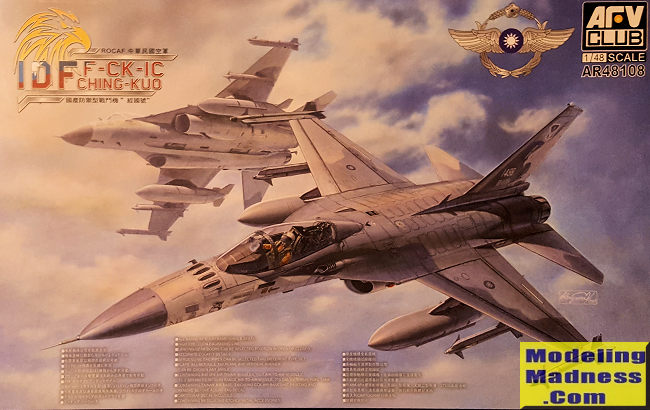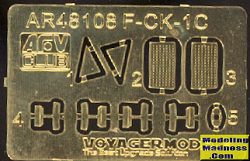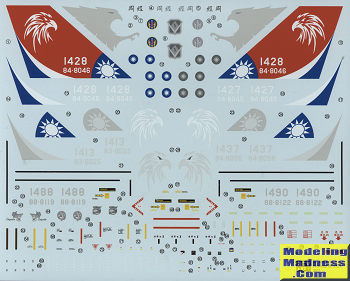
| KIT #: | AR48108 |
| PRICE: | $46.17 |
| DECALS: | Four options |
| REVIEWER: | Scott Van Aken |
| NOTES: | 2017 release |

| HISTORY |
The AIDC F-CK-1 Ching-Kuo (Chinese: 經國號戰機; pinyin: Jīngguó Hào Zhànjī), commonly known as the Indigenous Defense Fighter (IDF), is a multirole combat aircraft named after Chiang Ching-kuo, the late President of the Republic of China. The aircraft made its first flight in 1989. It was delivered to the Republic of China Air Force (Taiwan) in January 1994 and entered service in 1997. All 130 production aircraft were manufactured by 1999.
Taiwan initiated the IDF program when the United States refused to sell them F-20 Tigershark and F-16 Fighting Falcon jet fighters following diplomatic pressure from China. Taiwan therefore decided to develop an advanced indigenous jet fighter. The Aerospace Industrial Development Corporation (AIDC), based in Taichung, Taiwan, designed and built the IDF jet fighter. Production was stopped at 130 aircraft after the US finally agreed to sell the ROC 150 second hand F-16A/B Block 20 aircraft and France sold them 60 Mirage 2000 aircraft. All of the ROC's current fighter fleet is coming to the end of its useful life without major modifications so one can expect a new fighter to be purchased/developed to help deal with PRC aggression.
| THE KIT |
 The
kit itself is well up to modern standards for what aircraft modelers expect from
a kit in terms of detailing. The cockpit is a tub in which one adds the various
console pieces, rudder pedals, and a control stick. There are a few decals for
the screens of the main instrument panel with the rest of the raised detail on
the panels needing to be painted. AFV club states the interior is in FS 36375,
but I think that is too light and should be FS 36231 dark gull grey. This
assembly along with the nose gear well fit into the forward fuselage halves. One
then builds up the rest of the nose section and installs the six piece bang
seat.
The
kit itself is well up to modern standards for what aircraft modelers expect from
a kit in terms of detailing. The cockpit is a tub in which one adds the various
console pieces, rudder pedals, and a control stick. There are a few decals for
the screens of the main instrument panel with the rest of the raised detail on
the panels needing to be painted. AFV club states the interior is in FS 36375,
but I think that is too light and should be FS 36231 dark gull grey. This
assembly along with the nose gear well fit into the forward fuselage halves. One
then builds up the rest of the nose section and installs the six piece bang
seat.
The fuselage centerline missile rails and then built up. These can be modeled in the stowed or extended position. The main gear wells are installed in the lower fuselage/wing piece and any pylon holes are opened. The engine pieces, which are basically a tube with first compressor and burner cans are built up along with the engine intake trunking. Interesting is that the intake interior is painted FS 36118, a dark grey. These along with some braces are then glued in place, polycaps installed where the tailplanes attach and the upper fuselage/wing piece attached.
 Next the
speed brakes, which can be open or closed are installed followed by the flaps,
slats and tailplanes. The fin/rudder is assembled and attached along with the
engine intakes, nose cone and the forward fuselage. 2grams of nose weight is
required. This is all followed by a myriad of antennas, lights and small panels.
On the underside, the nose and main landing gear and doors are dealt with. These
also have some fairly small bits to attach. More work is done with various
antennas and probes. There are two p.e. vents that are glued in place.
Next the
speed brakes, which can be open or closed are installed followed by the flaps,
slats and tailplanes. The fin/rudder is assembled and attached along with the
engine intakes, nose cone and the forward fuselage. 2grams of nose weight is
required. This is all followed by a myriad of antennas, lights and small panels.
On the underside, the nose and main landing gear and doors are dealt with. These
also have some fairly small bits to attach. More work is done with various
antennas and probes. There are two p.e. vents that are glued in place.
 The next
several steps deal with the three missile types, fuel tanks, and pylons. There
are many separate fins for the missiles so this will be a bit time consuming.
The last step is the canopy and there are p.e. mirrors to attach to this piece.
It can be posed open or closed. You are provided a sheet of flexible red plastic
from which to make RBF tags and decals are also provided for this.
The next
several steps deal with the three missile types, fuel tanks, and pylons. There
are many separate fins for the missiles so this will be a bit time consuming.
The last step is the canopy and there are p.e. mirrors to attach to this piece.
It can be posed open or closed. You are provided a sheet of flexible red plastic
from which to make RBF tags and decals are also provided for this.
AFV Club provides a very well done instruction booklet that provides color information using a number of different hobby paints and FS 595 references as well. Markings are provided for four aircraft. Two are from 443 Wing and two are from 427 Wing. All four are in the standard five greys camouflage scheme with one of the 427 wing planes having a colorful fin marking and full color insignia. The large decal sheet is nicely done and provides stencils for the airframe and missiles. It also provides the option to paint the fin red instead of using the one-piece decal.
| CONCLUSIONS |
Not a kit that is on everyone's radar, but like other AFV kits, it is nicely done and with its interesting camouflage scheme, will make a nice one for your display shelf.
| REFERENCES |
https://en.wikipedia.org/wiki/AIDC_F-CK-1_Ching-kuo
November 2021
Copyright ModelingMadness.com. All rights reserved. No reproduction in part
or in whole without express permission. If you would like your product reviewed fairly and
fairly quickly, please
contact
the editor or see other details in the
Note to
Contributors.